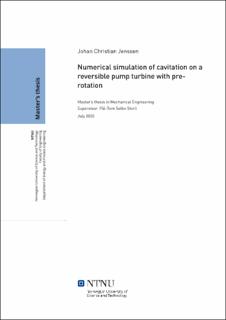| dc.contributor.advisor | Storli, Pål-Tore Selbo | |
| dc.contributor.author | Jenssen, Johan Christian | |
| dc.date.accessioned | 2021-09-20T16:53:07Z | |
| dc.date.available | 2021-09-20T16:53:07Z | |
| dc.date.issued | 2020 | |
| dc.identifier | no.ntnu:inspera:57317709:20901836 | |
| dc.identifier.uri | https://hdl.handle.net/11250/2779659 | |
| dc.description.abstract | For å redusere effekten av klimaendringene, må CO2 utslippene reduseres betraktelig. En løsning er å øke kapasiteten av fornybare energikilder. Pumpekraftverk er i dag en av de vanligste metodene for å stabilisere strømnettet og vil ha en nøkkelrolle når strømnettet i større grad skal forsynes med en økning av variable fornybare energikilder. Norge har stort potensialet for å bygge ut pumpekraftverk. En mulighet er å erstatte en turbin i et eksisterende kraftverk med en reversibel pumpeturbin. Gjennomføres dette, er det forventes at pumpeturbinen vil bli utsatt for uønsket kavitasjon når den er i pumpemodus. En foreslått løsning er å montere en boosterpumpe oppstrøms for pumpeturbinen. Dette øker innløpstrykket til pumpeturbinen og redusere eller eliminere kavitasjonen. Boosterpumpen kan produsere en pre-rotasjon ved innløpet til pumpeturbinen. Hvordan pre-rotasjon påvirker kavitasjonsegenskapene til pumpeturbinen undersøkes i denne oppgaven.
Stasjonære multifase CFD simuleringer av en eksisterende pumpende pumpeturbin med pre-rotasjon ble utført. Tre driftspunkter ble simulert i nærheten av driftspunket med beste virkningsgrad. Dette ble gjort med fire forskjellige pre-rotasjonen i tillegg til uten pre-rotasjon. Pre-rotasjonen var basert på en forenkling av en axial boosterpumpe og ble brukt som innløpsbetingelse i CFD simuleringen. Fra simuleringene ble det kjent at pre-rotasjon hadde signifikant virkning på pumpeturbinens kavitasjons egenskaper, i spesielt stor grad ved driftspunktet Q/QBEP = 1.1293. For dette driftspunktet var pre-rotasjonen som førte til de beste kavitasjonsegenskapene (laveste σ_R) negativ i forhold til løpehjulets rotasjons retning og reduserte σ_R med opptil 25.2%. Positiv pre-rotasjon er definert motsatt rettet av negativ pre-rotasjon. Under simuleringene med positiv pre-rotasjon observeres det at σ_R økte betraktelig, opp til 93% i forhold til simuleringene uten pre-rotasjon. Pre-rotasjon hadde vesentlig mindre effekt på kavitasjonsegenskapene ved de andre driftspunktene.
Negativ pre-rotasjon ved innløpet til pumpeturbinen økte løftehøyden til pumpeturbinen. Positiv pre-rotasjon reduserer løftehøyden til pumpeturbinen. For de simulerte driftspunktene ble det observert at alle pre-rotasjonene reduserte pumpeturbienens virkningsgrad. | |
| dc.description.abstract | In order to reduce the effect of global warming, the CO2 emissions needs to be reduced considerably. A solution is to increase the capacity of renewables. Pumped hydropower storage (PHS) is the most common way to stabilise the power grid and is increasingly important with the increase in intermittent renewables. Norway has a lot of potential for PHS. An option is retrofitting a reversible pump turbine (RPT) in an existing hydropower plant. The RPT is likely to experience unwanted cavitation in pump mode of operation when it replaces a turbine. A proposed solution is to add a booster pump upstream of the RPT which increases the inlet pressure and therefore reduce or eliminate cavitation. The booster pump might produce pre-rotation at the inlet of the RPT. The effect pre-rotation has on the cavitation performance of the RPT is investigated in this thesis.
Steady-state multiphase CFD simulations of an existing RPT in pump mode of operation were performed with pre-rotation. Three operating points near the best efficiency point (BEP) was simulated without pre-rotation in addition to four different pre-rotations. The pre-rotation was based on a simplification of an axial booster pump as the inlet condition of the CFD simulation. It was found that the pre-rotation had a significant impact on the cavitation performance, especially at the "high Q" operating point (Q/QBEP = 1.1293). For this operating point, the pre-rotation with the best cavitation performance (the lowest σ_R) was found to be negative pre-rotation (NPR) which reduced the σ_R with up to 25.2%. NPR is pre-rotation in the opposite direction as the impeller and positive pre-rotation (PPR) is the other way around. PPR for this operating point increased the σ_R significantly with up to 93% compared to no pre-rotation. Pre-rotation effected the other operating points in an insignificant amount compared to the high Q operating point.
NPR applied at the inlet of the RPT is increases the head and PPR reduces the head of the RPT. For the simulated operation points, it was also found that all the simulated pre-rotations reduced the efficiency of the RPT. | |
| dc.language | | |
| dc.publisher | NTNU | |
| dc.title | Numerical simulation of cavitation on a reversible pump turbine with pre-rotation | |
| dc.type | Master thesis | |
